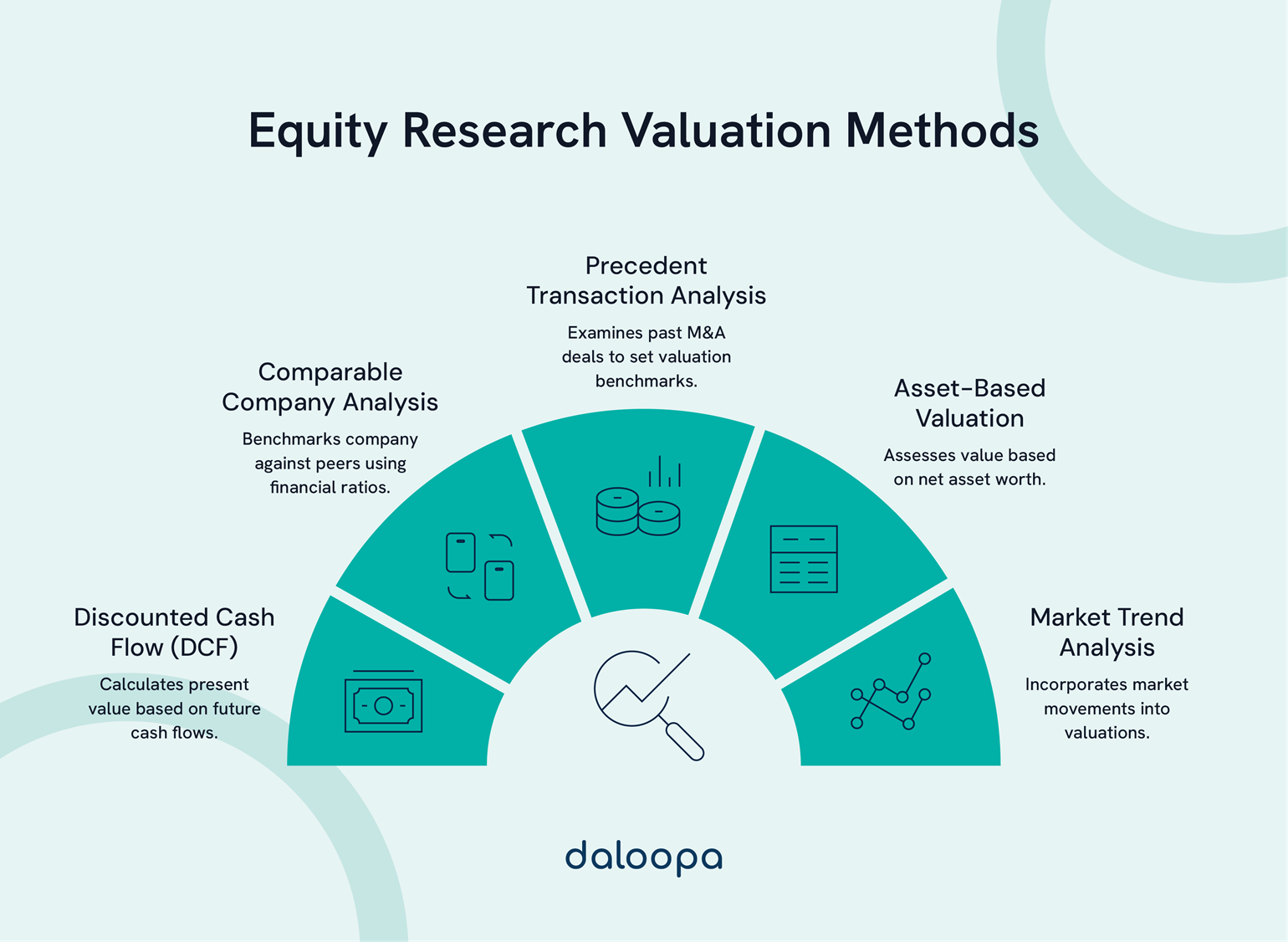What separates an ordinary investor from a truly successful one? Successful investors uncover hidden opportunities by mastering valuation techniques that reveal a company’s true worth long before the market catches on.
In today’s rapidly evolving financial landscape, equity research valuation methods remain a cornerstone of investment analysis. Analysts blend structured methodologies with deep market insights to produce investment recommendations that drive market movements.
This guide will walk you through the essential equity research valuation methods, share advanced techniques incorporating cutting-edge technologies like AI tools for equity analysts, and machine learning, and provide actionable insights to sharpen your analytical skills.
Key Takeaways
- Diverse Valuation Models: Analysts employ a range of equity research valuation methods—from discounted cash flow (DCF) to comparable company analysis—to establish reliable price targets.
- Integration of Advanced Technologies: New approaches such as Monte Carlo simulations and AI-driven forecasting refine traditional equity research valuation methods, including leveraging AI tools for equity analysts.
- Actionable Investment Strategies: Whether you’re starting your career or are a seasoned professional, mastering these equity research valuation methods empowers you to make decisive, informed investment decisions.

The Role of Valuation in Equity Research
Valuation serves as the strategic backbone of equity research. Analysts use valuation to shape investment strategies, uncover mispriced assets, and manage risks effectively. With accurate valuations, you identify profitable opportunities and safeguard your investments by distinguishing between overvalued and undervalued securities.
Why Valuation Analysis Matters
- Identifies Mispriced Assets: Detect hidden opportunities in the market.
- Strengthens Risk Management: Assess and mitigate potential risks before they affect portfolio performance.
- Optimizes Portfolio Decisions: Allocate capital effectively based on thorough data analysis.
- Supports Data-Driven Recommendations: Ground investment decisions in quantitative analysis and market insights.
Accurate valuations influence individual investment choices and contribute to overall market efficiency. When analysts generate robust and well-supported valuations, market prices reflect proper business fundamentals, reducing inefficiencies and helping prevent asset bubbles.
Core Valuation Methods in Equity Research
Equity analysts depend on several key equity research valuation methods that combine quantitative rigor with qualitative insights. Let’s explore these foundational techniques.
Discounted Cash Flow (DCF) Analysis
DCF analysis remains a go-to method for assessing a company’s intrinsic value.
How Analysts Use DCF Analysis:
- Forecasting Future Cash Flows: Analysts project free cash flows over a 5-10-year period by studying revenue trends, profit margins, and capital requirements.
- Determining Terminal Value: The terminal value can be estimated using perpetual growth assumptions or exit multiples, providing a long-term view of value.
- Key Components:
- Weighted Average Cost of Capital (WACC)
- Revenue growth projections
- Operating margin estimates
- Working capital and capital expenditure planning
DCF models offer intrinsic valuations that remain independent of short-term market sentiment. However, the precision of DCF models relies on the robustness of assumptions. Analysts routinely stress-test these inputs to account for different economic scenarios.
Comparable Company Analysis
Comparable company analysis benchmarks a target company against its peers.
Steps in Comparable Company Analysis:
- Select Peer Group: Choose companies with similar industry characteristics, size, and growth potential.
- Analyze Multiples: Common metrics include Enterprise Value/EBITDA, Price/Earnings (P/E), Price/Book Value (P/B), and EV/Sales.
- Adjust for Differences: Analysts fine-tune their comparisons by adjusting for variations in growth rates, profitability, and capital structures.
This method provides quick insights into how the market values similar companies and supports the identification of undervalued or overvalued securities.
Precedent Transaction Analysis
Precedent transaction analysis examines past mergers and acquisitions to set valuation benchmarks. This method leverages historical transaction data to determine how much acquirers have paid for similar companies.
Process Overview:
- Identify Relevant Transactions: Focus on deals within the last 3-5 years to ensure relevance.
- Calculate Transaction Multiples: Use metrics such as EV/EBITDA and P/E ratios from these deals.
- Adjust for Market Trends: Factor in market conditions and strategic synergies that may have influenced deal premiums.
Precedent transaction analysis becomes especially valuable when strategic acquisitions drive market trends. Reliable data sources include deal databases, SEC filings, and industry reports.
Advanced Valuation Techniques
Beyond the foundational methods, advanced equity research valuation methods refine intrinsic value assessments by incorporating industry-specific metrics, alternative data sources, and emerging technologies.
Asset-Based Valuation
Asset-based valuation calculates a company’s worth by examining its net asset value (NAV) and adjusting for market conditions.
Key Elements Include:
- Evaluating Tangible Assets: Property, machinery, and inventory contribute to the asset base.
- Valuing Intangible Assets: Intellectual property, brand equity, and patents receive special attention.
- Adjustments for Market Conditions: Analysts update book values to reflect current market prices and economic factors.
Asset-based valuation proves particularly useful in capital-intensive sectors such as real estate, manufacturing, and financial services.
Market Trend Analysis
Market trend analysis enhances traditional valuation models by integrating technical analysis and broader market insights.
How Analysts Leverage Market Trends:
- Technical Indicators: Analysts monitor moving averages, trading volumes, and momentum indicators.
- Sector Rotation Patterns: Observing shifts in sector performance helps pinpoint optimal entry and exit opportunities.
- Incorporation of Sentiment Analysis: Recent advancements allow analysts to track social media sentiment and news trends, further refining their forecasts.
Integrating market trends with core valuation methods improves forecast accuracy using AI tools for equity analysts, and prepares analysts to anticipate price movements amid fluctuating economic conditions.
Embracing Alternative Models and Technologies
Modern valuation increasingly benefits from advanced equity research valuation methods that go beyond traditional models.
- Monte Carlo Simulations: Analysts use these simulations to model the probability of different outcomes by running thousands of scenarios, capturing the uncertainty inherent in financial forecasting.
- Real-Time Valuation: This method values the flexibility of future decision-making, which is especially important in industries facing rapid change.
- AI and Machine Learning: AI tools for equity analysts process vast datasets, AI-powered models uncover non-traditional signals in the market. These technologies analyze historical trends, real-time news, and even alternative data sources such as credit card transactions and web traffic, providing deeper insights and more accurate forecasts.
Innovative platforms like Daloopa empower analysts with automated data extraction and advanced analytics. Integrating Daloopa’s AI-driven tools into your workflow allows you to streamline data collection, improve model accuracy, and focus on generating actionable insights.
Practical Application and Skill Development
Mastering equity research valuation requires not only theoretical knowledge but also practical experience. Real-world application and continuous skill development enable analysts to stay ahead in a competitive landscape.
Financial Modeling Techniques
Robust financial models form the backbone of compelling valuation. Proficiency in Excel and financial modeling techniques is crucial for any analyst.
Steps to Develop Effective Models:
- Construct Three-Statement Models: Link the income statement, balance sheet, and cash flow statement to create a comprehensive financial picture.
- Forecast Future Performance: Use historical trends and industry outlooks to project revenues, expenses, and cash flows.
- Conduct Sensitivity Analysis: Evaluate how changes in key assumptions affect the model’s outcome. This approach helps identify potential risks and opportunities.
Incorporate advanced tools like Daloopa’s data extraction services to streamline the process of importing financial data directly into your models. Automating data extraction saves time and reduces errors, allowing you to focus on analysis and decision-making.
Breaking Into the Equity Research Industry
Launching a career in equity research demands technical skills, networking, and industry knowledge. Whether you’re a junior analyst or transitioning from another field, practical experience, and strategic career moves pave the way for success.
Actionable Steps for Career Growth:
- Networking: Engage with professionals via LinkedIn, attend industry conferences, and participate in finance groups. Establishing connections can open doors to mentorship and job opportunities.
- Certifications and Courses: Pursue professional credentials like the CFA and complete specialized financial modeling and valuation courses.
- Hands-On Experience: Participate in stock pitch competitions and internships. Real-world case studies provide valuable insights, such as how Warren Buffett’s valuation approach has outperformed traditional models.
- Build a Portfolio: Create and maintain a portfolio of detailed stock research reports. A strong portfolio demonstrates your analytical capabilities and industry expertise.
By following these steps, you position yourself as a credible and innovative analyst capable of navigating established and emerging valuation methodologies.
Mastering Equity Research Valuation
To excel in equity research, you must cultivate analytical rigor, develop deep market knowledge, and embrace disciplined investment principles. The synthesis of quantitative models and qualitative insights drives the creation of comprehensive investment theses that guide strategic decision-making.
Key Factors for Equity Analyst Success
Successful analysts combine financial modeling techniques with industry specialization and clear communication skills. Here’s how you can stand out:
- Financial Modeling Techniques: Develop detailed financial models that capture the nuances of a company’s operations. Regularly update your models to reflect current market conditions.
- Industry Specialization: Deepen your understanding of specific tech, manufacturing, or healthcare sectors. Specialization allows you to account for unique industry challenges and opportunities.
- Analytical Rigor: Apply critical thinking to evaluate management quality, competitive positioning, and corporate governance. Look for patterns and trends that signal potential risks and rewards.
- Clear Communication: Present your findings in concise, well-structured reports that effectively communicate your analysis. Strong communication skills are essential when explaining complex valuation models to stakeholders.
By mastering these skills, you gain the confidence to make decisive investment decisions that align with long-term strategies. Analysts who blend bottom-up company research with top-down market analysis build robust investment theses that stand up to scrutiny even under volatile market conditions.
Make the Most of Daloopa Today
Ready to transform your financial analysis process? Discover how Daloopa can automate your data extraction, enhance your financial models, and empower you to make data-driven decisions with precision.
Visit Daloopa today to learn more about our innovative solutions and take your equity research to the next level.



